Self-Aligned Liquid Crystals on Anisotropic Nano/Microstructured Lanthanum Yttrium Strontium Oxide Layer
Abstract
:1. Introduction
2. Materials and Methods
2.1. LaYSrO Thin-Film Deposition and Alignment Treatment Using Only Brush-Coating Process
2.2. Investigation of the Brush-Coated LaYSrO Film Properties
2.3. Alignment States and EO Performances of LCs on the Brush-Coated LaYSrO Layer
3. Results and Discussions
4. Conclusions
Author Contributions
Funding
Institutional Review Board Statement
Informed Consent Statement
Data Availability Statement
Conflicts of Interest
References
- Lee, W.K.; Yu, S.; Engel, C.J.; Reese, T.; Rhee, D.; Chen, W.; Odom, T.W. Concurrent design of quasi-random photonic nanostructures. Proc. Nat. Acad. Sci. USA 2017, 114, 8734–8739. [Google Scholar] [CrossRef] [Green Version]
- Koo, W.H.; Jeong, S.M.; Araoka, F.; Ishikawa, K.; Nishimura, S.; Toyooka, T.; Takezoe, H. Light extraction from organic light-emitting diodes enhanced by spontaneously formed buckles. Nat. Photonics 2010, 4, 222–226. [Google Scholar] [CrossRef]
- Ducros, C.; Brodu, A.; Lorin, G.; Emieux, F.; Pereira, A. Optical performances of antireflective moth-eye structures. Comparison with standard vacuum antireflection coatings for application to outdoor lighting LEDs. Surf. Coat. Technol. 2019, 379, 125044. [Google Scholar] [CrossRef]
- Gao, L.; Zhang, Y.; Zhang, H.; Doshay, S.; Xie, X.; Luo, H.; Shah, D.; Shi, Y.; Xu, S.; Fang, H.; et al. Optics and nonlinear buckling mechanics in large-area, highly stretchable arrays of plasmonic nanostructures. ACS Nano 2015, 9, 5968–5975. [Google Scholar] [CrossRef]
- Khang, D.Y.; Jiang, H.; Huang, Y.; Rogers, J.A. A stretchable form of single-crystal silicon for high performance electronics on rubber substrates. Science 2006, 311, 208–212. [Google Scholar] [CrossRef] [Green Version]
- Ding, X.; Tang, Y.; Li, Z.; Li, J.; Xie, Y.; Lin, L. Multichip LED modules with V-groove surfaces for light extraction efficiency enhancements considering roughness scattering. IEEE Trans. Electron Devices 2017, 64, 182. [Google Scholar] [CrossRef]
- Wang, Y.; Villada, A.; Zhai, Y.; Zou, Z.; Chen, Y.; Yin, X.; Xiao, J. Tunable surface wrinkling on shape memory polymers with application in smart micromirror. Appl. Phys. Lett. 2019, 144, 193701. [Google Scholar] [CrossRef]
- Lee, D.W.; Kim, D.H.; Oh, J.Y.; Liu, Y.; Seo, D.-S. Nanopattern transfer on bismuth gallium oxide surface via sol-gel stamp process applied for uniform liquid crystal alignment. Appl. Surf. Sci. 2022, 576, 151712. [Google Scholar] [CrossRef]
- Purica, M.; Budianu, E.; Rusu, E.; Danila, M.; Gavrila, R. Optical and structural investigation of ZnO thin films prepared by chemical vapor deposition (CVD). Thin Solid Film. 2002, 403–404, 485–488. [Google Scholar] [CrossRef]
- Ellmer, K. Magnetron sputtering of transparent conductive zinc oxide: Relation between the sputtering parameters and the electronic properties. J. Phys. D-Appl. Phys. 2000, 33, R17. [Google Scholar] [CrossRef]
- Liu, Z.; Yang, Q.; Zhang, H.; Wang, L.; Li, D.; Yang, D. Magnesium catalyzed growth of SiO2 hierarchical nanostructures by a thermal evaporation process. Nanotechnology 2008, 19, 165601. [Google Scholar] [CrossRef] [PubMed]
- Chen, Y.-C.; Yang, C.-F.; Hsueh, E.-Y. The application of AZOY transparent conductive oxide film in multifilm-coated polycarbonate optical glasses. J. Electrochem. Soc. 2010, 157, H987. [Google Scholar] [CrossRef]
- Herrmann, C.F.; Fabreguette, F.H.; Finch, D.S.; Geiss, R.; George, S.M. Multilayer and functional coatings on carbon nanotubes using atomic layer deposition. Appl. Phys. Lett. 2005, 87, 123110. [Google Scholar] [CrossRef] [Green Version]
- Sun, D.M.; Li, Y.X.; Ren, Z.J.; Bryce, M.R.; Li, H.H.; Yan, S.K. Anisotropic highly-conductive films of poly(3-methylthiophene) from epitaxial electropolymerization on oriented poly(vinylidene fluoride). Chem. Sci. 2014, 5, 3240–3245. [Google Scholar] [CrossRef] [Green Version]
- Ren, Z.J.; Zhang, X.; Li, H.H.; Sun, X.L.; Yan, S.K. A facile way to fabricate anisotropic P3ht films by combining epitaxy and electrochemical deposition. Chem. Commun. 2016, 52, 10972–10975. [Google Scholar] [CrossRef]
- Arumugam, S.; Li, Y.; Pearce, J.; Charlton, M.D.B.; Tudor, J.; Harrowven, D.; Beeby, S. Spray-coated organic light-emitting electrochemical cells realized on a standard woven polyester cotton textile. IEEE Trans. Electron Devices 2021, 68, 1717. [Google Scholar] [CrossRef]
- Kwak, J.; Bae, W.K.; Lee, D.; Park, I.; Lim, J.; Park, M.; Cho, H.; Woo, H.; Yoon, D.Y.; Char, K.; et al. Bright and efficient full-color colloidal quantum dot light-emitting diodes using an inverted device structure. Nano Lett. 2012, 12, 2362–2366. [Google Scholar] [CrossRef] [PubMed]
- Jiang, C.; Zhong, Z.; Liu, B.; He, Z.; Zou, J.; Wang, L.; Wang, J.; Peng, J.; Cao, Y. Coffee-ring-free quantum dot thin film using inkjet printing from a mixed-solvent system on modified ZnO transport layer for light-emitting devices. ACS Appl. Mater. Interfaces 2016, 8, 26162–26168. [Google Scholar] [CrossRef]
- Lee, J.J.; Park, H.G.; Han, J.J.; Kim, D.H.; Seo, D.-S. Surface reformation on solution-derived zinc oxide films for liquid crystal systems via ion-beam irradiation. J. Mater. Chem. C 2013, 1, 6824–6828. [Google Scholar] [CrossRef]
- Liu, Y.; Lee, J.H.; Seo, D.-S. Ion beam fabrication of aluminum-doped zinc oxide layer for high-performance liquid crystals alignment. Opt. Express 2016, 24, 17428. [Google Scholar] [CrossRef]
- Song, I.H.; Jeong, H.-C.; Lee, J.H.; Won, J.; Kim, D.H.; Lee, D.W.; Oh, J.Y.; Jang, J.I.; Liu, Y.; Seo, D.-S. Selective liquid crystal driving mode achieved by controlling the pretilt angle via a nanopatterned organic/inorganic hybrid thin film. Adv. Opt. Mater. 2021, 9, 2001639. [Google Scholar] [CrossRef]
- Schmidt, S.; Motschmann, H.; Hellweg, T.; von Klitzing, R. Thermoresponsive surfaces by spin-coating of PNIPAM-co-PAA microgels: A combined AFM and ellipsometry study. Polymer 2008, 49, 749–756. [Google Scholar] [CrossRef]
- Palka, K.; Syrovy, T.; Schröter, S.; Brückner, S.; Rothhardt, M.; Vlcek, M. Preparation of arsenic sulfide thin films for integrated optical elements by spiral bar coating. Opt. Mater. Express 2014, 4, 384–395. [Google Scholar] [CrossRef]
- Huh, Y.H.; Bae, I.-G.; Jeon, H.G.; Park, B. Homogeneous PCBM layers fabricated by horizontal-dip coating for efficient bilayer heterojunction organic photovoltaic cells. Opt. Express 2016, 24, A1321. [Google Scholar] [CrossRef] [PubMed]
- Wu, X.; Lan, S.; Zhang, G.; Chen, Q.; Chen, H.; Guo, T. Morphology of a ternary blend solar cell based on small molecule: Conjugated polymer:fullerene fabricated by blade coating. Adv. Funct. Mater. 2017, 27, 1703268. [Google Scholar] [CrossRef]
- Guo, C.; Gao, X.; Lin, F.-J.; Wang, Q.; Meng, L.; Bian, R.; Sun, Y.; Jiang, L.; Liu, H. In situ characterization of the triphase contact line in a brush coating process: Toward the enhanced efficiency of polymer solar cells. ACS Appl. Mater. Interfaces 2018, 10, 39448–39454. [Google Scholar] [CrossRef] [PubMed]
- Gibbons, W.M.; Shannon, P.J.; Sun, S.-T.; Swetlin, B.J. Surface-mediated alignment of nematic liquid crystals with polarized laser light. Nature 1991, 351, 49–50. [Google Scholar] [CrossRef]
- Yaroshchuk, O.; Kravchuk, R.; Dobrovolskyy, A.; Qiu, L.; Lavrentovich, O.D. Planar and tilted uniform alignment of liquid crystals by plasma-treated substrates. Liq. Cryst. 2004, 31, 859. [Google Scholar] [CrossRef]
- Singh, G.; Prakash, G.V.; Choudhary, A.; Biradar, A.M. Homeotropic alignment of nematic liquid crystals with negative dielectric anisotropy. Phys. B Condens. Matter 2010, 405, 2118–2121. [Google Scholar] [CrossRef]
- Ouchi, Y.; Moria, I.; Seia, M.; Itoa, E.; Arakiab, T.; Ishiia, H.; Sekia, K.; Kondoc, K. Polarized XANES studies on the rubbed polyimide for liquid crystal alignment; new applicability to the tribology of the polymer systems. Phys. B Condens. Matter 1995, 208-209, 407–408. [Google Scholar] [CrossRef]
- Haaren, J.V. Wiping out dirty displays. Nature 2001, 411, 29–30. [Google Scholar] [CrossRef] [PubMed]
- Lee, J.-W.; Park, H.-G.; Jeong, H.-C.; Seo, D.-S. Enhanced electro-optical properties of electrically controlled birefringence cells on solution-derived lanthanum oxide films treated with ion beam irradiation. ECS Solid State Lett. 2015, 4, R13. [Google Scholar] [CrossRef]
- Lei, P.; Zhu, J.; Zhu, Y.; Jiang, C.; Yin, X. Evolution of composition, microstructure and optical properties of yttrium oxide thin films with substrate temperature. Surf. Coat. Technol. 2013, 229, 226. [Google Scholar] [CrossRef]
- Jeong, H.-C.; Park, Y.S.; Park, K.Y.; Kim, M.S.; Park, H.-G.; Oh, B.-Y.; Seo, D.-S. Homogeneous liquid crystal alignment of spin-coated strontium oxide and its application for superior LCD performance. J. Sol-Gel Sci. Technol. 2016, 78, 11–18. [Google Scholar] [CrossRef]
- Han, K.Y.; Miyashita, T.; Uchida, T. Accurate measurement of the pretilt angle in a liquid crystal cell by an improved crystal rotation method. Mol. Cryst. Liq. Cryst. Sci. Technol. Sect. A-Mol. Cryst. Liq. Cryst. 1994, 241, 147. [Google Scholar] [CrossRef]
- Scheffer, T.J.; Nehring, J. Accurate determination of liquid-crystal tilt bias angles. J. Appl. Phys. 1977, 48, 1783. [Google Scholar] [CrossRef]
- Kim, D.H.; Lee, D.W.; Oh, J.Y.; Won, J.; Liu, Y.; Seo, D.-S. Self-aligned liquid crystals and enhanced electro-optical properties on solution-processed aluminum gallium tin zinc oxide surfaces. J. Mater. Res. Technol. 2022, 20, 291–302. [Google Scholar] [CrossRef]
- Chae, B.; Kim, S.B.; Lee, S.W.; Kim, S.I.; Choi, W.; Lee, B.; Ree, M.; Lee, K.H.; Jung, J.C. Surface morphology, molecular reorientation, and liquid crystal alignment properties of rubbed nanofilms of a well-defined brush polyimide with a fully rodlike backbone. Macromolecules 2002, 35, 10119. [Google Scholar] [CrossRef]
- Kikuchi, H.; Logan, J.A.; Yoon, D.Y. Study of local stress, morphology, and liquid-crystal alignment on buffed polyimide surfaces. J. Appl. Phys. 1996, 79, 6811. [Google Scholar] [CrossRef]
- Berreman, D.W. Solid Surface Shape and the Alignment of an Adjacent Nematic Liquid Crystal. Phys. Rev. Lett. 1972, 28, 1683. [Google Scholar] [CrossRef]
- Fukuda, J.-I.; Yoneya, M.; Yokoyama, H. Surface-Groove-Induced Azimuthal Anchoring of a Nematic Liquid Crystal: Berreman’s Model Reexamined. Phys. Rev. Lett. 2007, 98, 187803. [Google Scholar] [CrossRef] [PubMed]
- Mun, H.-Y.; Jeong, H.-C.; Lee, J.H.; Won, J.-H.; Park, H.-G.; Oh, B.-Y.; Seo, D.-S. Poly(styrene–maleic anhydride) films as alignment layers for liquid crystal systems via ion-beam irradiation. RSC Adv. 2016, 6, 76743. [Google Scholar] [CrossRef]
- Li, X.; Choy, W.C.H.; Huo, L.; Xie, F.; Sha, W.E.I.; Ding, B.; Guo, X.; Li, Y.; Hou, J.; You, J.; et al. Dual plasmonic nanostructures for high performance inverted organic solar cell. Adv. Mater. 2012, 24, 3046–3052. [Google Scholar] [CrossRef]
- Li, J.; Pan, Y.; Xiang, C.; Ge, Q.; Guo, J. Low temperature synthesis of ultrafine α-Al2O3 powder by a simple aqueous sol–gel process. Ceram. Int. 2006, 32, 587. [Google Scholar] [CrossRef]
- Lee, W.-K.; Choi, Y.S.; Kang, Y.-G.; Sung, J.; Seo, D.-S.; Park, C. Super-fast switching of twisted nematic liquid crystals on 2D single wall carbon nanotube networks. Adv. Funct. Mater. 2011, 21, 3843–3850. [Google Scholar] [CrossRef]
- Teowee, G.; McCarthy, K.C.; McCarthy, F.S.; Bukowski, T.J.; Davis, D.G., Jr.; Uhlmann, D.R. Preparation and characterization of sol-gel derived Y2O3 thin films. J. Sol-Gel Sci. Technol. 1998, 13, 895–898. [Google Scholar] [CrossRef]
- Surplice, N.A. The electrical conductivity of calcium and strontium oxides. Br. J. Appl. Phys. 1966, 17, 175. [Google Scholar] [CrossRef]
- Mahalingam, T.; Radhakrishnan, M.; Palasubramanian, C. Dielectric behaviour of lanthanum oxide thin film capacitors. Thin Solid Film. 1981, 78, 229–233. [Google Scholar] [CrossRef]
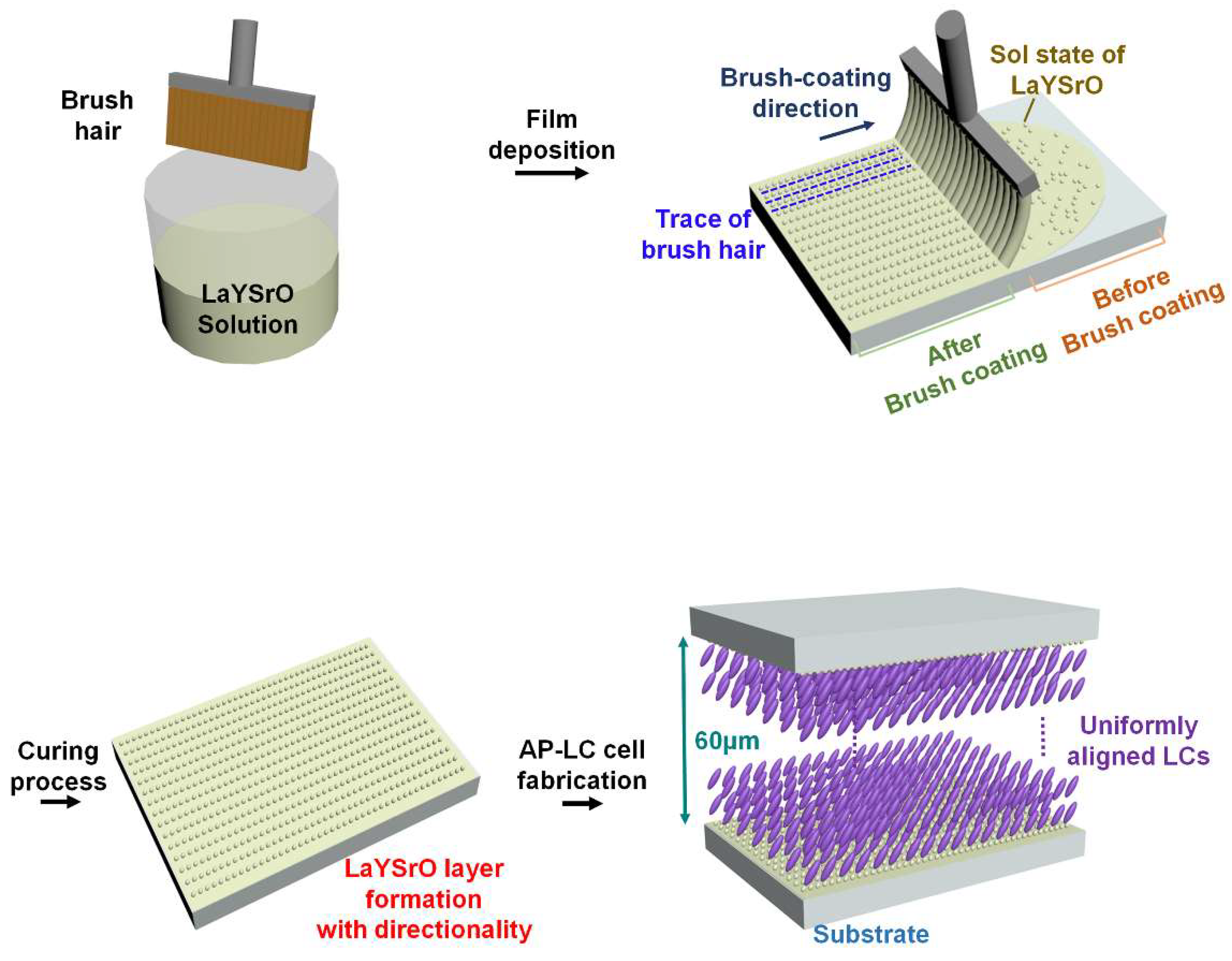
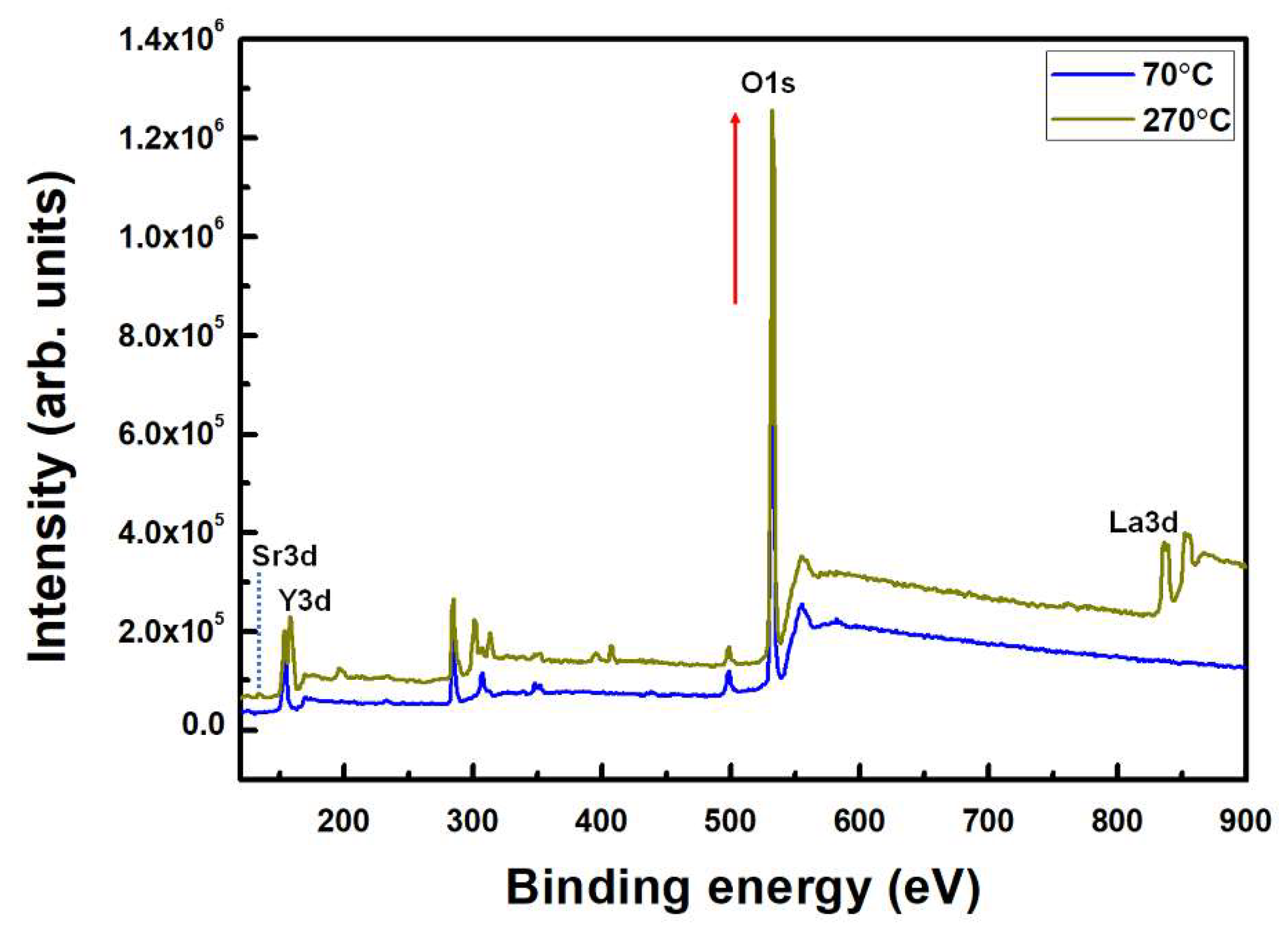


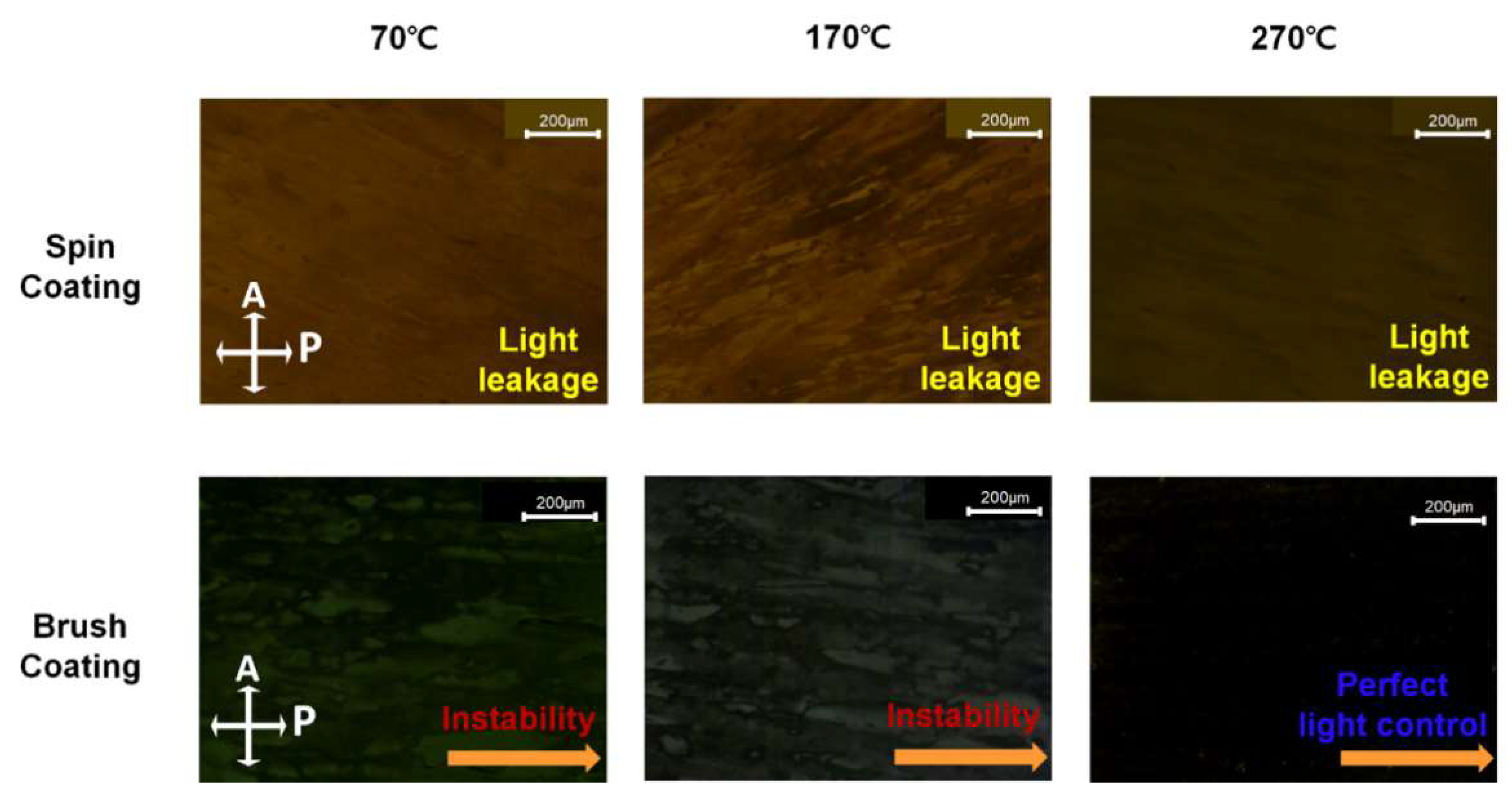

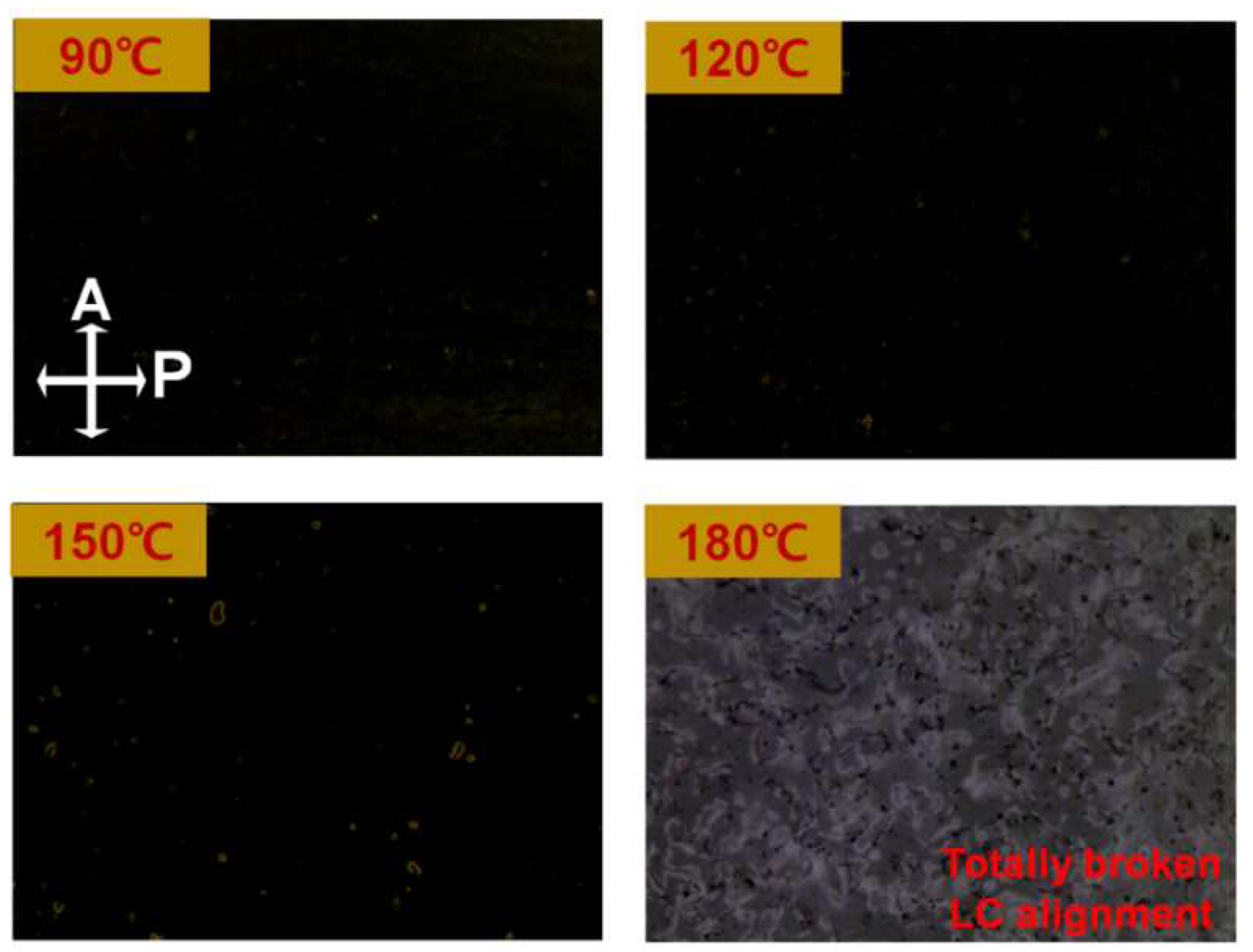
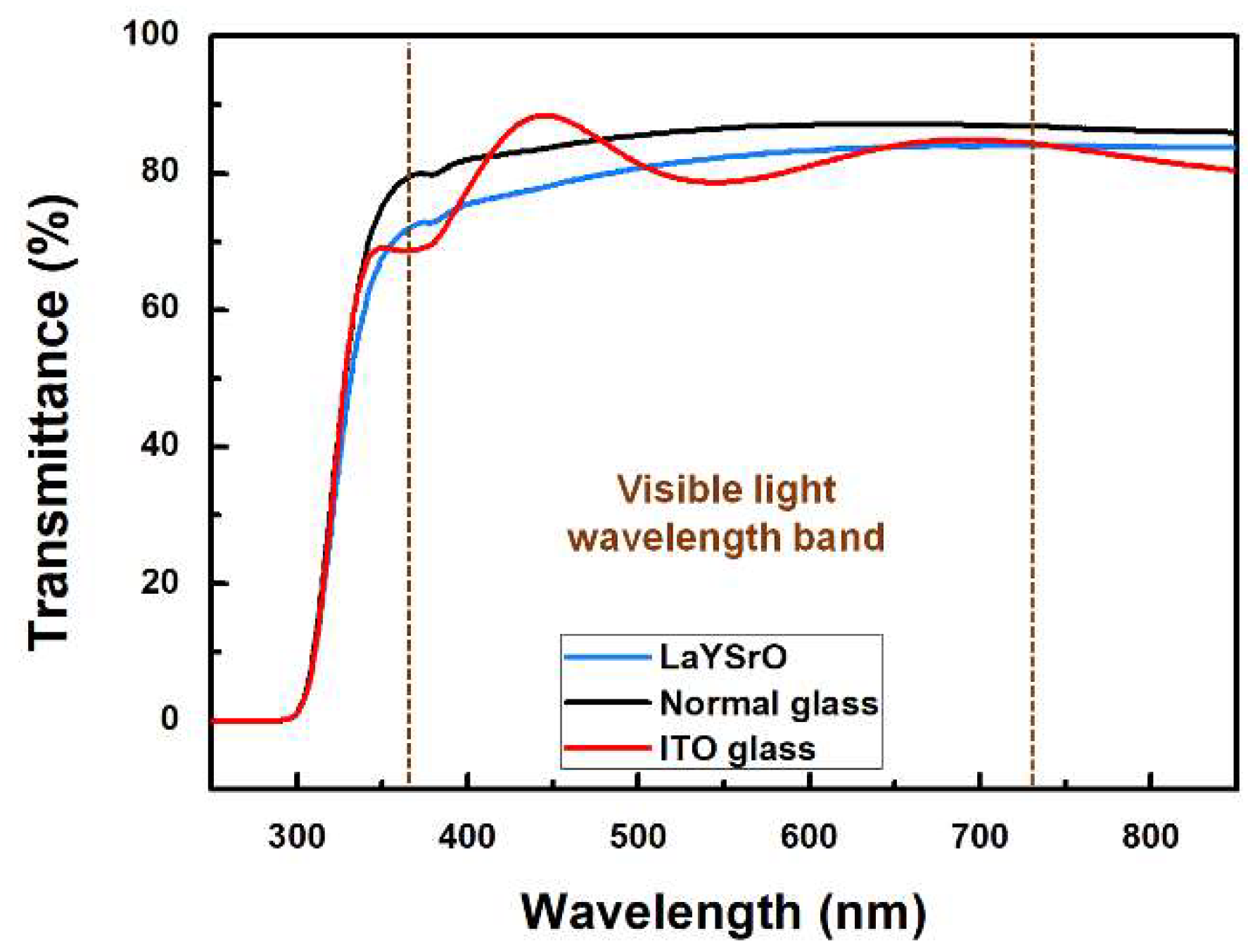


Publisher’s Note: MDPI stays neutral with regard to jurisdictional claims in published maps and institutional affiliations. |
© 2022 by the authors. Licensee MDPI, Basel, Switzerland. This article is an open access article distributed under the terms and conditions of the Creative Commons Attribution (CC BY) license (https://creativecommons.org/licenses/by/4.0/).
Share and Cite
Lee, D.-W.; Kim, D.-H.; Oh, J.-Y.; Kim, D.-H.; Choi, S.-H.; Kim, J.-A.; Park, H.-G.; Seo, D.-S. Self-Aligned Liquid Crystals on Anisotropic Nano/Microstructured Lanthanum Yttrium Strontium Oxide Layer. Materials 2022, 15, 6843. https://doi.org/10.3390/ma15196843
Lee D-W, Kim D-H, Oh J-Y, Kim D-H, Choi S-H, Kim J-A, Park H-G, Seo D-S. Self-Aligned Liquid Crystals on Anisotropic Nano/Microstructured Lanthanum Yttrium Strontium Oxide Layer. Materials. 2022; 15(19):6843. https://doi.org/10.3390/ma15196843
Chicago/Turabian StyleLee, Dong-Wook, Dong-Hyun Kim, Jin-Young Oh, Dae-Hyun Kim, Se-Hoon Choi, Jin-Ah Kim, Hong-Gyu Park, and Dae-Shik Seo. 2022. "Self-Aligned Liquid Crystals on Anisotropic Nano/Microstructured Lanthanum Yttrium Strontium Oxide Layer" Materials 15, no. 19: 6843. https://doi.org/10.3390/ma15196843






